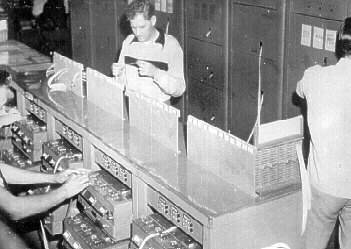
Radio-teletype positions on OFACS – during WWII
Year and location unknown

Radio-teletype positions on OFACS – during WWII
Year and location unknown
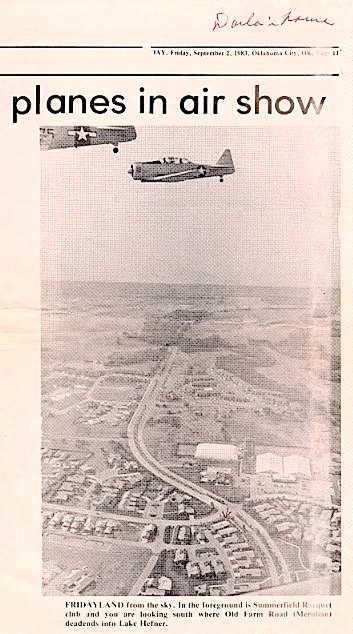
Oklahoma City, OK Air Show Article, September 2, 1983
Caption above reads: “FRIDAYLAND from the sky. In the foreground is Summerfield Resort club and you are looking south where Old Farm Road (Meridian) deadends into Lake Hefner”
![]()
Submitted by Steve Wolff
Plate XXXVI. General Electric Company Cluster Beacon, about 1927
Caption above reads: In addition to the 24-in. beacons, it was found advisable in certain sections to place cluster beacons having less candlepower. They consist of four automobile head-lamps surmounted by a top lamp as shown, and to turn at approximately 10 r.p.m. Tests of such a beacon using 21-cp. automobile-type lamps, show that it is visible at a distance of 40 miles in good weather.
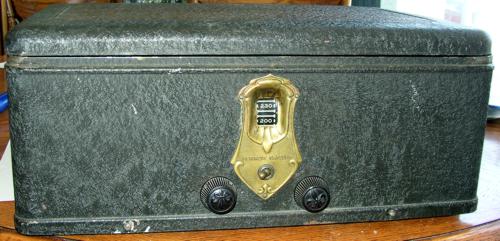
Submitted by Raymond Duck
Early Lighthouse or Radio Station Radio
CAN YOU IDENTIFY THIS RADIO’S ORIGIN?
The above radio is manufactured by DeForest Crosley, 1927, and is contained in a metal box. It may have been used in the early days of radio beacon stations or lighthouses. The tuner scale ranges from 200-560. Does anyone know how this radio may have been utilized for navigation?
The following information was provided Anthony Martini in 2021 that may be of some help.
“Before I was an ATC Center controller hired in 1979, I was an Air Force navigator for 6 years. Many aircraft from the 1920’s up had a “radio direction finder” of some sort…. which was the easiest thing to operate in the cockpit. It’s use was very simple. Connected to a loop antenna on the aircraft, a needle in the cockpit would simply point to the source of the broadcast, like any ADF of the last 50 years. Since the Crosley bandbox was both battery powered and/or electrical powered, it is possible that an aircraft may have had the Bandbox onboard for use as a navigational aid….receiver only.
The metal box radio in your photo was normally installed in any attractive wooden cabinet for home use, and attached to external speakers, in other words, the metal box was the “guts” of the radio cabinet….much like car radios in the dashboard. I do not know why a normal AM radio would be in an ATC facility or lighthouse other than recreation, unless in 1927 some aircraft could transmit by radio signal (either voice of Morse Code) within the frequency band of the Bandbox, then the ATC/lighthouse could have had a directional loop antenna to point to the bearing of the aircraft/ship. That would require more research, but there certainly was radio transmission from aircraft before 1927.
As a humorous sidenote…..in the 1970’s USAF, we were flying the F-4 Phantom jet, and in training sessions the “good guy” would takeoff first and patrol somewhere unknown….then the “bad guy” would takeoff and try to find and “kill” the “good guy”. If the “good guy” crew was new, the “bad guy” would key the mic and ask for a “short count” to check the radio….and of course, the new crew would comply, unaware that the “bad guy” was obtaining an ADF relative bearing which gave away the “good guy’s” position by the needle pointing to the transmitting aircraft….and then the fight started…..”
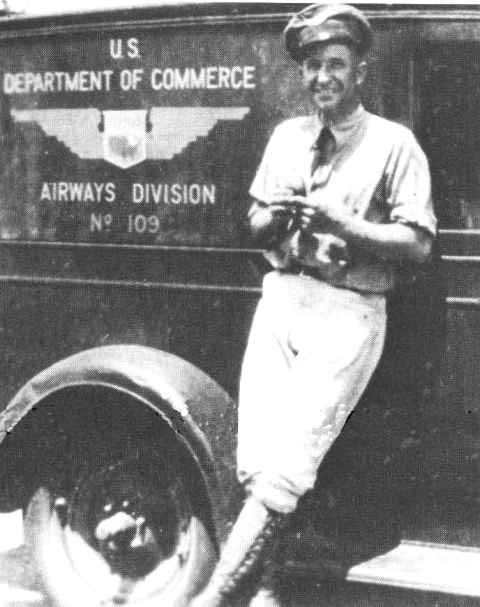
Airway Technician, U.S. Department of Commerce
Airways maintenance technician, “Dusty” Rhodes takes a break alongside his sector truck in the late ’30s. Unlike their modern counterparts, the airway station keepers were required to wear distinctive uniforms on the job.
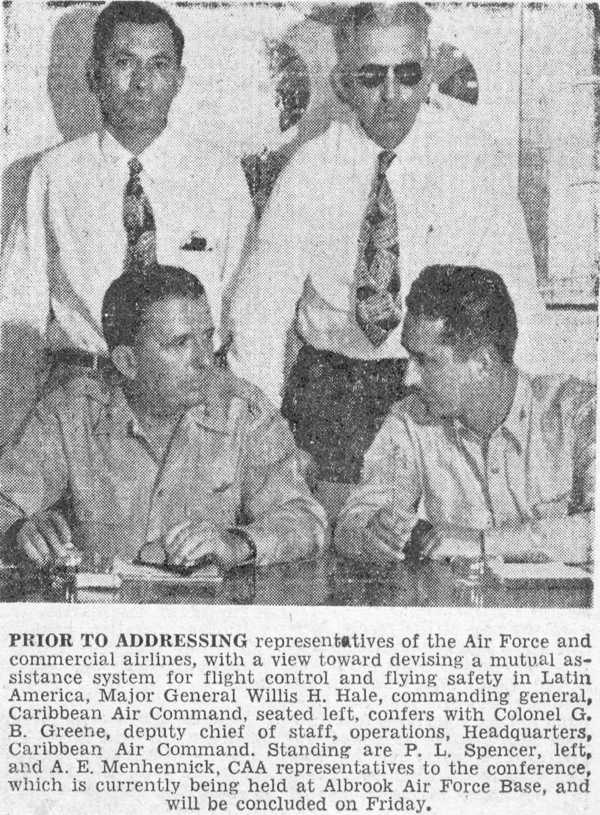
Submitted by John Spencer, son of Percy L. Spencer above
CAA Balboa Radio Station (WHZ), Canal Zone, 1949
1949 newspaper article on the Air Safety Conference
BELOW: CAA Balboa Radio Station (WHZ), Canal Zone, 1948
This was printed on card stock depicting employee names and their assigned positions while stationed at the Civil Aeronautics Administration, Balboa Radio Station. According to Percy L. Spencer, listed on the second card above as Foreign Aeronautical Communications oversight, Balboa Station, along with New Orleans, Miami, and San Juan were major points of control for air traffic from the United States and Central and South America. Balboa was a
large facility.
CAA Balboa Radio Station (WHZ), Canal Zone, 1948
Christmas card from CAA Balboa Radio Station, WHZ
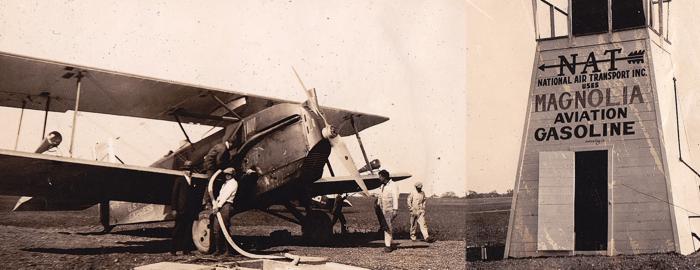
Submitted by Darla Shelden
Miss Oklahoma City Mail Plane (about 1926)
The photo, taken from a family album, contained the following handwritten caption:
“Miss Oklahoma City, the first airplane to carry mail from California.” Note: The first airmail plane carried 314 pounds of airmail out of Oklahoma City, OK but the aircraft name is unknown.
![]()
Submitted by Paul Domeier
Crouse-Hinds DCB-10 Beacon Light
Comments by Paul Domeier.
This particular unit was at KVCB Nut Tree in Vacaville, CA, and the local lore is that it was originally installed at Travis AFB (formerly Fairfield-Suisun Army Air Base) in Fairfield, CA… but as this is not a white/white/green flash unit, I’m not so sure of that.
There’s a real Buck Rogers type feature that doesn’t show up well in the photos: The unit has two bulbs, but only fires one at a time. The second bulb is spring-loaded in an auto-switchover mechanism that would slam it into the primary position if the first bulb failed… or maybe it’s supposed to be triggered by a remote switch?
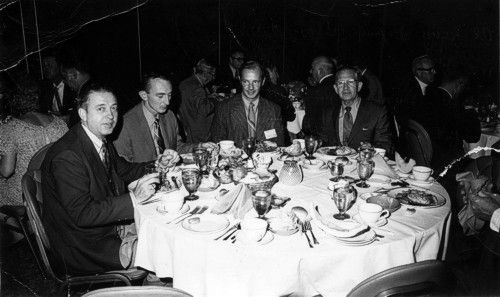
Submitted by Ed Dietz
Air Traffic Managers Dinner, November 1971. Location unknown
Listed left to right:
Al Leroy, Deputy Albany Tower, New York
Ed Dietz, Manager, Glens Falls FSS, New York
Bill Armkenecht, Deputy Buffalo FSS, New York
Al Tridmann, Chief, Niagara Falls Tower, New York
Bill Cantwell (only hands visible, far right)